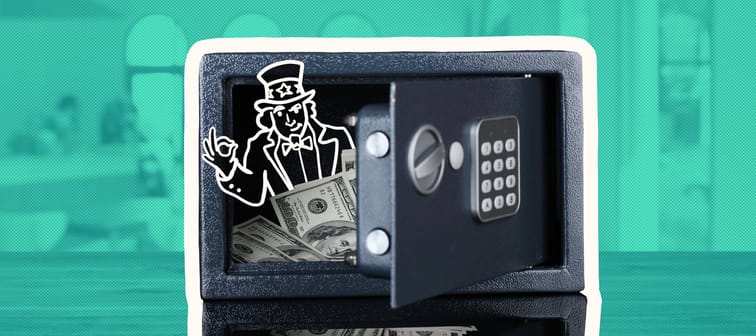Savings bonds introduction
Modern savings bonds were introduced in 1935 by then-Treasury Secretary Henry Morgenthau, Jr., with two goals: to encourage households to save more and to help fund government spending without having to rely exclusively on large private investors and commercial banks.
Various types of bonds had been offered at different points in history dating back to 1776, when private citizens helped raise $27 million to finance the Revolution.
Earn more with a high-yield savings account
Ready to make your money work harder? These savings accounts offer some of the most competitive rates available today. Compare top options from a range of trusted institutions and choose the one that fits your financial goals.
Boost your savings nowWhat is a savings bond?
A U.S. savings bond is a debt security issued by the U.S. Department of the Treasury — or in layman’s terms, it’s a loan to Uncle Sam.
When you redeem your savings bond, the government repays the amount you lent them, plus interest — similar to a certificate of deposit.
A savings bond earns interest until it “matures” at 30 years, but you can cash out penalty-free anytime after five years.
More: How to cash in savings bonds
Types of savings bonds
There are currently two types of U.S. savings bonds available for purchase — Series EE and Series I. A third type, Series HH, is no longer sold but can still be redeemed.
Series EE U.S. savings bonds are also known as "patriot bonds," and you purchase them at face value. That means if you want to buy a $50 EE savings bond, you pay $50 for it.
Series EE bonds issued from May 2005 onward earn a fixed interest rate for up to 30 years. Older EE bonds purchased before May 2005 pay a variable interest rate that updates every six months in May and November.
The interest you earn on your Series EE bond compounds semi-annually, adding to its face value. When you redeem EE savings bonds, you receive the full face value plus your interest on top.
If you hold the bond for 20 years, the government guarantees it will be worth twice as much as you paid for it, regardless of your interest rate.
Series I U.S. savings bonds protect from inflation, which is what the "I" stands for. Your returns include both a fixed rate of interest plus additional earnings based on the inflation rate.
Like Series EE bonds, you purchase Series I bonds at their face value and earn semi-annually compounding interest for up to 30 years.
In a deflationary economy — like during the Great Recession — your earnings rate could potentially be lower than the fixed rate, but it will never dip below zero, so your initial investment is safe.
Series HH U.S. savings bonds were discontinued in 2004, which means they're no longer available for purchase. But if you have Series HH bonds, you can still redeem them.
Any Series HH savings bonds that haven’t matured will continue to earn interest at an annual rate of 1.5%, with interest paid out every six months via direct deposit to your bank account. HH bonds mature in 20 years.
More: Compare the best savings accounts
This 2 minute move could knock $500/year off your car insurance in 2025
OfficialCarInsurance.com lets you compare quotes from trusted brands, such as Progressive, Allstate and GEICO to make sure you're getting the best deal.
You can switch to a more affordable auto insurance option in 2 minutes by providing some information about yourself and your vehicle and choosing from their tailor-made results. Find offers as low as $29 a month.
Find the best rate for youAre savings bonds a good investment?
Savings bonds boast a plethora of benefits for savers. Bonds in general serve as an effective portfolio diversification tool. Because they have a low correlation with other investment asset classes, when you add them to your portfolio, they can help buffer the shock of market crashes.
To split your eggs between multiple baskets, financial advisers have traditionally recommended the 60/40 investing rule — 60% stocks and 40% bonds. The 60/40 rule has lost traction in recent years of rock-bottom bond yields. But to keep up with inflation, those low bond yields are making a turnaround.
After choosing how much of your portfolio to allocate to bonds, you need to pick what type of bonds to invest in.
Savings bonds are among the safest. To lose your money, the government itself would need to collapse. Since that’s unlikely to happen, the biggest risk would be earning zero interest on a Series I savings bond if inflation went negative.
In addition to diversifying your portfolio, savings bonds can also supplement your retirement savings. With Series EE bonds and I bonds, you can invest up to $10,000 in each type per year, which means heaps more tax-deferred savings beyond the contribution limits of your IRA or 401(k).
That said, there is one big thing to consider with savings bonds — they are temporarily illiquid, meaning the money you invest isn’t immediately available if you need it.
You can’t touch your savings bond money for the first year. And if you redeem it before five years, you’ll sacrifice three months of earned interest. That means if you redeem a bond after 18 months, you’ll only earn 15 months worth of interest.
Savings bonds are more for stable, long-term savings than for unexpected emergencies. You should already have an emergency savings fund built up, ideally in a high-yield savings account.
When you have a lump sum of money that you would like to invest for a longer period, savings bonds can help balance out the risks associated with the stock market. But due to the lower returns, it’s generally not a good idea to put all your eggs in the savings bond basket.
To get the most from your savings bonds, hold them until they mature to benefit from compounding interest.
How do savings bonds work?
You can purchase savings bonds online through the U.S. Treasury Department's TreasuryDirect.gov website. Buying bonds at their face value guarantees that you will be paid interest until the bonds mature.
After holding the bonds for five years, you can redeem them penalty-free at any time, and they continue earning interest for a total of 30 years.
Every six months, the interest you’ve built up gets added to your principal. This compounding interest helps your investment snowball faster.
Determining the value of a savings bond
Your savings bonds earn interest at the fixed rate set in the year you purchased them.
To check how much a savings bond is worth, enter the date of purchase, the series and the denomination into the Treasury's savings bond calculator.
If your bond is less than five years old, the calculator automatically subtracts the three-month interest penalty.
How to cash in savings bonds
As of February 2022, the government reported that more than $26 billion is sitting dormant in unredeemed, matured savings bonds.
If you've got money tied up in old savings bonds, you can search for it on TreasuryHunt.gov — don't let it grow cobwebs.
To redeem electronic EE bonds or I bonds, simply log into your Treasury Direct account and follow the instructions. The money will be deposited electronically into your checking account or savings account within a couple of business days.
You can cash out paper EE and I bonds at most financial institutions. You can also mail your bond with FS Form 1152 to the Treasury Retail Securities Services at P.O. Box 9150, Minneapolis, MN 55480-9150.
How do taxes on a savings bond work?
You’ll have to pay federal taxes on the savings bond interest you earn, but not state or local taxes.
You can choose to pay what you owe on the interest you earn each year, or you can pay it all at once when you cash out, give up ownership or the bond matures.
There is a loophole to avoid federal taxes on your interest income by using it for higher education expenses for you, your spouse or your dependents. There are a few eligibility requirements, but if you qualify, it’s an easy way to boost your return on investment.
Can you buy a savings bond for a child?
The simple, long-term nature of savings bonds makes them good gifts for children. As they grow, they watch their money grow.
They’re also a great tool to teach the basics of interest and investing. In 30 years, they'll be thankful for the lesson, and even more grateful for the fully matured bond.
When you buy the bond, you can put it solely in the child’s name or you can add yourself as a co-owner.
If you’re a co-owner, you’ll be responsible for the taxes. If the child is the sole owner, they’ll be responsible for taxes when they redeem it as an adult.
If they redeem as a minor or a full-time student between the ages of 19 and 24, they may be subject to what’s known as the kiddie tax, which taxes children’s investment earning over $2,200.
But as long as their income for the year amounts to less than $11,000 from interest and dividends, you may be able to report their income on your tax return instead of having to file their own return.
The richest 1% use an advisor. Do you?
Wealthy people know that having money is not the same as being good with money. Advisor.com can help you shape your financial future and connect with expert guidance . A trusted advisor helps you make smart choices about investments, retirement savings, and tax planning.
Try it now








